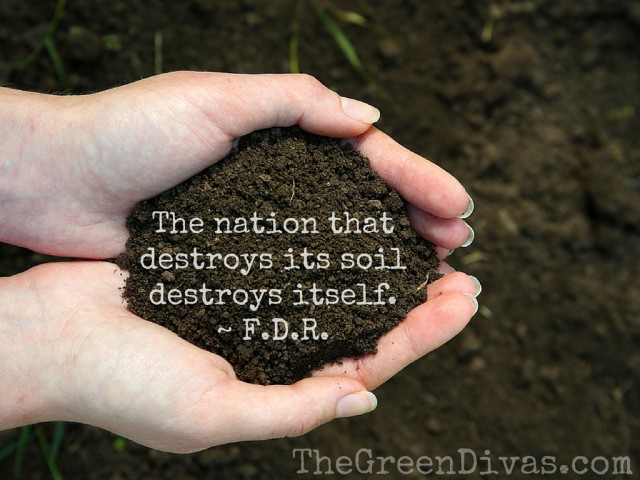
Did you know that Fall is a great time to get your soil* ready for next year’s garden?
Listen to this Green Divas in the Garden segment for some soil prep tips that can ensure a better garden next Spring. Then read on for more…
Invest in soil prep now
We have time to devote to soil prep now—the frenzied activity focused on flowers and fruits is finished.
We can have our soil tested, put all those falling leaves to good use, and plant cover crops to our gardens’ advantage. These steps will result in an ever-improving healthy soil.
Be aware that we can only change the make-up of a soil to a limited extent. For example, it’s not going to matter how much mulching and amending I do in the high desert of Arizona—those soils are not going to be hospitable in the long term for plants that want to live in moist acid peat bogs!
Knowing what will grow best in your area, for your soil type, light conditions, gardening zone and exposure (wind, humidity, etc.) is important for plant selection. Putting that knowledge together with optimal soil preparation will supercharge your results!
5 reasons for soil testing
According to the University of Massachusetts, (which has other great info, by the way) there are five good reasons for getting a soil test. You will…
1. know what fertilizer you need to add
2. know what your soil pH is and what you can do to adjust it if necessary
3. have an economic benefit since you only need to buy what you need and you won’t be spending money on excess amendments,
4. be environmentally responsible since you won’t be polluting waterways with excess nutrients that runoff or pollute the soil since they aren’t used by the plants.
5. be alerted to elevated levels of lead or other toxic heavy metals. (if you request those results in your test—if in the inner city, I would request it.)
Taking a soil sample is an easy process
Basically you decide what you’re going to plant, choose the area (keeping in mind the sun/shade/wind/other factors like black walnut trees!), gather soil samples from a few sites in the area, mix them in a bucket, put a small sample of the mix in a plastic bag and label it. Send it in with the lab’s form and a check and, for example, for around $20, receive a report telling you what should be added to the soil, if anything, in order to best prepare the area to grow the types of plants you want to grow. (The $20 version does not include a heavy metal test at my lab.)
If you’re going to grow vegetables, the requirements will be VERY different than if you are planting a perennial border. The soil reports I order tell me the pH of the soil in the area and the amount of amendment to be added to adjust the pH. They also tell me the amount of organic matter in the soil and the levels of plant nutrients like phosphorus, nitrogen and potassium.
There are detailed instructions at the University of Massachusetts, and other soil science lab sites like algreatlakes.com.
Beneficial cover crops
Planting cover crops is another way to add beneficial organic matter and nutrients to soil. As an added benefit, fall cover crops can be useful to reduce weeds in open beds, reduce the amount of soil lost to water or wind erosion in the winter if the area is not planted (such as in a vegetable bed) and improve the amount of organic matter in the soil if the crop is tilled in as green manure.
Cover crops can even be sown in between rows of vegetables during the summer to reduce weeds and reduce soil compaction. We are sowing annual rye in raised garden beds that held tomatoes and peppers that will be finished in the next few weeks. It will germinate at low temperature and can be planted later than other cover crops.
Highmowingseeds.com and groworganic.com are good organic cover crop seed sources that also provide excellent resources for calculating what types of cover crops will work best for your garden needs.
Leaf mulch is free
Every year we look forward to leaves falling from the trees since they’re “free” mulch we can use in our garden for the winter and in years to come.
We usually mow the leaves that fall at least three times to break them up, then apply them in our mixed borders (small flowering trees, shrubs, perennials and ground covers) at the depth of 2″ if we have enough. If we ever had enough, we would add some to our compost piles. When we do have some stragglers at the end of the season, we rake them into the borders whole.
Don’t leave them on the lawn, since they’ll smother the grass. But otherwise, they’ll break down over the winter and provide food and cover for the plants and animals that are living in your gardens!
Fall is a great time for soil prep! Make your garden’s soil healthier and ready for 2016 gardening through soil testing, cover crops and mulching with leaves. A little investment of time and effort now will result in a richer soil that is easier to work in, has better yields and is better for the environment than one that is over-fertilized with synthetic compounds. Your plants will thank you!
* The difference between dirt and soil? Dirt is dead soil.
Bonus:
Listen to the latest full episode of the Green Divas Radio Show …
Catch the latest Green Divas Radio Show—and other green, healthy and free radio shows—daily on GDGDRadio.com (or get the GDGD Radio app)!
Main image via ShutterStock
[dynamic-sidebar id=’Custom Widget 2′]